- Why is Ganesh Chaturthi celebrated and bringing Ganesha home. What are rituals (shodashopachar puja) performed during Ganesh Chaturthi Puja? Eco-friendly benefits of Matoli.
To read part 1
Origin
of Ganesha worship in India
Festivals hold a special place in the lives of individuals and communities, and they serve as occasions for joy, unity, and cultural expression. In India, where religious and cultural diversity is rich, festivals are celebrated with great enthusiasm and fervour. The Ganesh Chaturthi festival, especially in Maharashtra, is a prominent example of how festivals are celebrated with pomp and joy, and it has a significant historical and cultural background.
Why Ganesha Chaturthi
According to Ganesh Puranas, birth of Ganesh
is on Magha, Vinayak Chaturthi; but his Parthiva form, earthly incarnation has
occurred on Bhadrapad Chaturthi. The Vrata of Ganesh Worship starts from
Bhadrapada Chaturthi and ends on Magh Chaturthi. Parthiv Ganesh is worshipped
only in month of Bhadrapada from Chaturthi to Chaturdashi

Ganesh
Murti Installation
The Ganesh Chaturthi festival typically
begins on Bhadrapada Shuddha Chaturthi, when devotees bring a murti of Lord
Ganesh into their homes. The murti is installed with a special ceremony called Pranapratishthapana and worshipped with shodashopachar puja, which involves 16
rituals and offerings.
Decoration
Homes and public places are decorated in
a special way to welcome Lord Ganesh. Elaborate decorations, including flower
garlands, lights, and artistic displays, are common during this time.
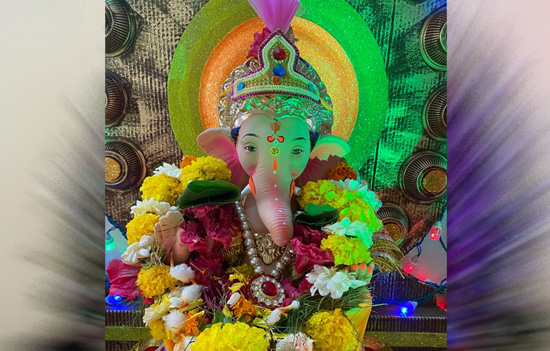
Food
Special menus are prepared on this auspicious day, featuring a variety of sweets and savory dishes. Modak, a sweet dumpling, is a traditional favorite and is considered Lord Ganesh's favourite food.
Duration of celebration
varies
Ganesh Chaturthi can be celebrated for
different durations, such as one and a half days, five days, seven days, and
ten days. The most widely celebrated duration is the ten-day festival, which
culminates on Anant Chaturdashi.
Historical Significance
The worship of Lord Ganesh at home dates
back to the 6th century C.E., but it was during the National Freedom Struggle
that Lokmanya Bal Gangadhar Tilak played a pivotal role in transforming this
household worship into a public festival. He encouraged people to celebrate
Ganesh Chaturthi publicly, turning it into a social and political event.
Sarvajanik Ganeshotsava
The public celebration of Ganesh
Chaturthi, known as Sarvajanik
Ganeshotsava, gained immense popularity during the freedom struggle. It served as a platform for people to come together, promote unity, and discuss social and political issues. The festival became a symbol of national pride and played a significant role in India's quest for independence.
Today, Ganesh Chaturthi is not only a
religious festival but also a cultural and social celebration. It brings people
from all walks of life together to participate in the joyous festivities,
create artistic Ganesh murtis, and immerse them in water bodies on Anant
Chaturdashi. The festival showcases the spirit of unity, devotion, and cultural
heritage that is deeply rooted in Indian society. It continues to be one of the
most widely celebrated and cherished festivals in Maharashtra and throughout
India.
Ganesha murti is indeed one
of the central elements of Ganesh Chaturthi Puja. Devotees can choose from a
variety of murtis available in the market, and in recent times, there has been
a growing emphasis on eco-friendly murtis.
Here are some important
aspects related to the Ganesha murti and the rituals performed during Ganesh
Chaturthi Puja.
Types
of Murti
Ganesha murtis come in
various sizes, styles, and materials. Traditionally, murtis are made of clay,
but today, you can find murtis made from materials such as plaster of Paris,
metal, and even eco-friendly materials like paper mache. The choice of material
often depends on personal preferences and environmental considerations.
Face
Covered
It is a common practice to
bring the Ganesha murti home with the face covered. The unveiling of the murti
and the Pranapratishthapana (invoking the divine presence) ceremony is a
significant and sacred moment during the festival.
Use
of Flowers and Leaves
In Hinduism, offering
flowers and leaves is a common practice when worshipping deities. Lord Ganesha
is no exception, and devotees use a variety of fresh flowers and leaves, such
as lotus petals, marigolds, and bilva leaves, to adorn the murti and make offerings
during the puja.
MATOLI
The tradition of decorating
Matoli is a beautiful and eco-friendly practice observed in the Konkan and Goa
regions of India during festivals, particularly during the Ganesh Chaturthi.
Matoli refers to a decorative arrangement or hanging made from various natural
elements, such as leaves, fruits, vegetables, and flowers.
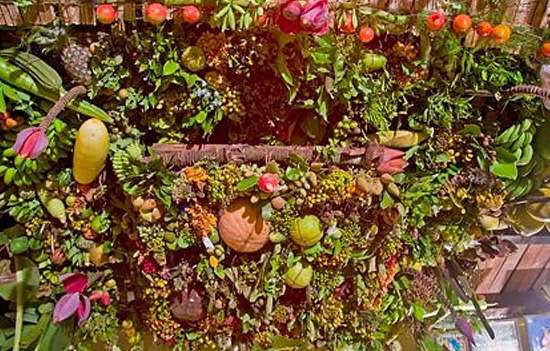
This tradition serves
several meaningful purposes:
1. Environmental Awareness: Matoli
decorations provide an excellent opportunity for children and individuals to
learn about the local flora, vegetables, and fruits that are part of their
surroundings. It fosters environmental awareness and encourages a deeper
connection with nature.
2. Cultural Expression: Matoli is a form
of cultural expression that reflects the unique traditions and practices of the
region. It showcases the use of locally available materials to create beautiful
and artistic displays.
3. Eco-Friendly: Matoli decorations are
inherently eco-friendly because they are made from natural and biodegradable
materials. Unlike synthetic decorations, Matoli decorations have a minimal
ecological footprint.
4. Community Bonding: The process of
creating Matoli often involves the participation of family members, neighbours,
and the community as a whole. It is a collaborative effort that fosters a sense
of togetherness and community bonding.
5. Festival Spirit: Matoli decorations
enhance the festive spirit of occasions like Ganesh Chaturthi. They add color,
vibrancy, and a sense of celebration to the surroundings.
6. Cultural Heritage: Matoli is a part of
the rich cultural heritage of the Konkan and Goa regions. It is a tradition
that has been passed down through generations, preserving the cultural identity
of the community.
7. Sustainability: The use of natural
materials in Matoli aligns with sustainability principles, as it reduces the
demand for synthetic and non-biodegradable decorations.
8. The Matoli tradition is a wonderful
example of how festivals can be celebrated in an environmentally conscious and
culturally meaningful way. It promotes a harmonious relationship between humans
and nature while celebrating the spirit of festivity and community.
Ganesh
Puja Timing
Ganesh Puja can be performed
during the morning, and it is customary for devotees to take a bath and wear
clean clothes before starting the puja. The timing of the puja can vary from
one household to another, depending on family traditions and preferences.
GANESH PUJA
Sixteen
Rituals (Shodashopachara)
The Shodashopachara Puja involves performing sixteen specific rituals
and offering sixteen items to Lord Ganesha. The various steps involved in
performing the Ganesh Puja, with their respective mantras and rituals, are
below. This sequence of rituals is a traditional and essential way to worship
Lord Ganesh with devotion and reverence. Each step carries its significance and
symbolizes offerings to the deity.
1. Avahana:
Invocation of Lord Ganesh to invite his divine presence and blessings.
2. Pratishthapana: The installation of the Lord Ganesh murti while
chanting mantras, establishing a sacred connection.
3. Asana Samarpana: Offering a seat to Lord Ganesh with flowers,
symbolizing hospitality and respect.
4. Padya Samarpana: Offering water to wash the feet of Lord Ganesh, a
gesture of purification and respect.
5. Arghya
Samarpan: Offering scented water to the deity, representing the washing
away of impurities and negative energies.
6. Achaman: Offering water to Lord Ganesh for sipping, purifying both
the deity and the worshiper.
7. Snana: Giving a ceremonial bath to Lord Ganesh with water while
chanting mantras, signifying the purification of the deity. Panchamruta Snana: Bathing Lord Ganesh
with a mixture of five nectars (milk, curd, honey, ghee, and sugar),
symbolizing nourishment and purity.
8. Suvasita Snanam: Bathing Lord Ganesh with scented oil, enhancing
his divine radiance.
9. Shuddhodaka
Snanam: Giving Lord Ganesh a bath with pure water, signifying cleanliness
and spiritual purity.
10. Vastra Samarpana and Uttariya
Samarpana: Offering new clothes and a sacred thread to the deity,
symbolizing respect and honor.
11. Yajnopavita Samarpan: Presenting the sacred thread (Yajnopavita) to
Lord Ganesh, indicating initiation and spiritual connection.
12. Gandha: Offering scented sandalwood paste (gandha) to Lord Ganesh,
signifying fragrance and purity.
13. Akshata: Offering unbroken rice (akshata) to the deity, symbolizing
prosperity and abundance.
14. Pushpamala and Patri: Presenting a garland of flowers and 21 leaves to Lord Ganesh, each leaf holding medicinal and symbolic significance. Red Coloured flowers are Lord Ganesha's favourite ones. There is story about Raktavarna-use of red flowers in Ganesh Purana - in Dwapara Yuga,Gajanana killed Sindurasur. The red hibiscus is offered to the deity as the flower is radiant and has a pleasant fragrance. Fresh flowers signify beauty, purity, softness and fragrance.
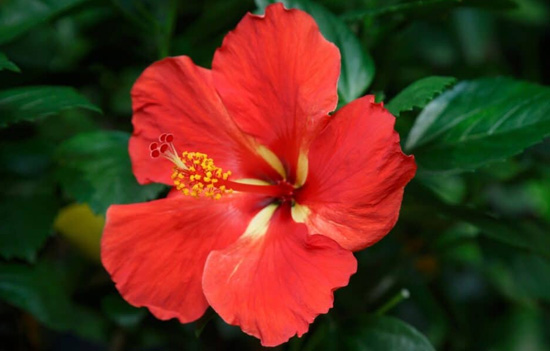
15. Sindoor: Applying vermilion (sindoor) as tilak on the forehead of
Lord Ganesh, symbolizing auspiciousness and protection.
16. Dhoop:
Offering incense (dhoop) to Lord Ganesh, purifying the environment and creating
a fragrant atmosphere for worship.
Naivedya/Offering
1. Coconut
- Also known as Shreefal - every part of the coconut is useful in some way or the other. In Ganesh Pujan, it signifies the presence of Shiva and is supposed to attract all the blessings from heaven. Breaking the coconut signifies breaking the hurdles in life and Lord Ganesha—the Vighna Vinayak and Vignaharta is worshipped for the exact
same reason.
2. MODAK is a
sweet which is a favourite of Lord Ganesha. It has a special significance on
Ganesh Chaturthi Puja. In the ceremony, one must make an offering of twenty-one
Modaks to the deity. Keep your heart, mind, body and soul immersed in the
bhakti of Lord Ganesha and you shall receive his blessings. Steamed (Ukadiche) Modak or fried (Talaniche) Modak are offered.
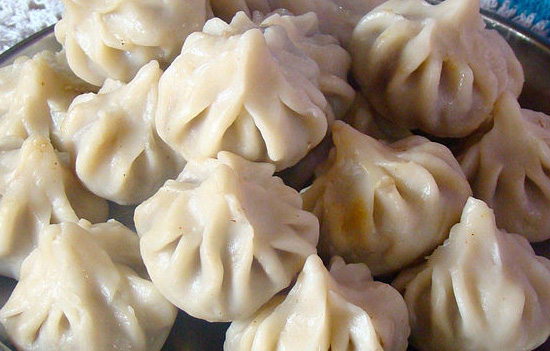
These rituals collectively
create a sacred and spiritually charged atmosphere during the Ganesh Puja,
allowing devotees to connect with Lord Ganesh on a deeper level and seek his
blessings for wisdom, prosperity, and the removal of obstacles.
Special
Chanting
Arati and Bhajans are
rendered.
On Ganesha Chaturthi,
devotees often perform special pujas like Eka
Vinshati Nameh Ganesh Puja, where twenty-one different names of Lord Ganesha are chanted, and Lord Ganesha Anga Puja, where specific parts of the deity's body are worshipped. These pujas enhance the depth of devotion and spiritual connection with Lord Ganesha. They perform recitation-Avartana of Atharvashirsha.
To see videos of recitation Arati
...Sukhakarta dukhharta
by Lata Mangeshwar And Atharvashirsha
by Pradip Bhide
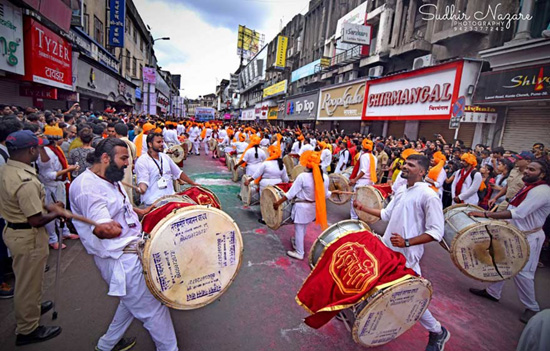 Celebrations at Laxmi road, Pune are famous.
Celebrations at Laxmi road, Pune are famous.
Visarjan
(Immersion)
At the end of the Ganesh
Chaturthi festival, devotees participate in the visarjan ceremony, where the
Ganesha murti is immersed in a water body, symbolizing the departure of Lord
Ganesha after his visit to Earth. This immersion is accompanied by prayers and
devotional songs.
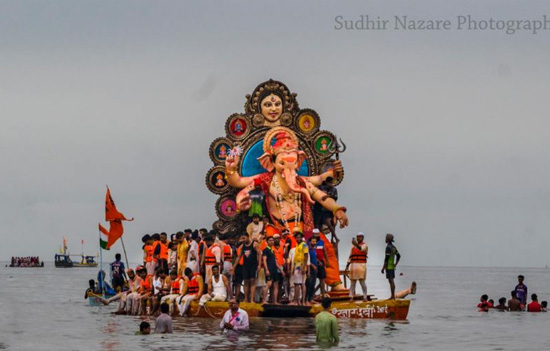 Visarjan at Girgaum Chowpatty, Mumbai.
Visarjan at Girgaum Chowpatty, Mumbai.
Ganesh Chaturthi is a time
of great devotion, celebration, and community involvement. The rituals and
customs associated with this festival vary from region to region but are marked
by a deep reverence for Lord Ganesha and a desire for his blessings of wisdom,
prosperity, and the removal of obstacles.
Also read How is Gauri Pooja celebrated
Author Dr Moghe is Assistant Professor (Archaeology), Centre of Archaeology, Centre for Extra Mural Studies, University of Mumbai.
Also read
1. Album Ganesha
Temple in Pondicherry
2. Album Ganesha in
Indonesia
3. Read Ganapati
Atharvasirha
4. Maharashtra’s famous Ashtavinayaka Temples
5. Deeper symbolic
meaning of Ganesha and message conveyed
6. Ganesha is global God in a globalised world
7. Enshrining of
Ganesha
8. In Hindi - Amazing
traditions and statues of Ganesha